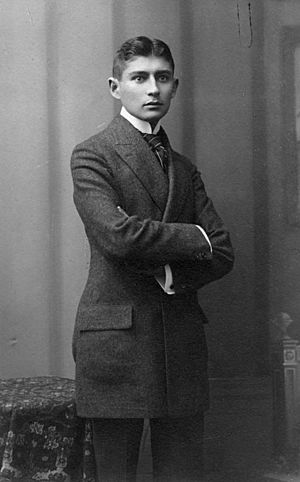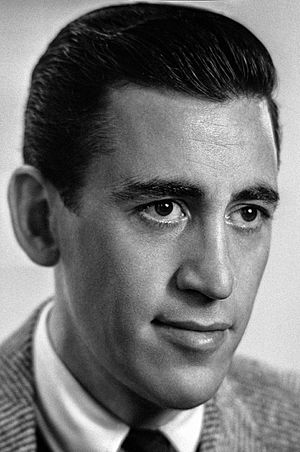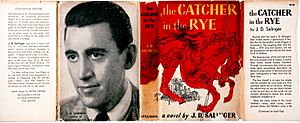Lotte Jacobi facts for kids
Lotte Jacobi (born August 17, 1896 – died May 6, 1990) was a famous American photographer. She was known for taking amazing portraits and for her work as a photojournalist. Her black-and-white photos were often very clear and showed people's true feelings. She photographed everyday people and many important artists, thinkers, and leaders of her time.
Contents
Her Amazing Photos
Lotte Jacobi's style of photography was special. She liked to take pictures that felt natural and real. She wanted to show the true personality of the people she photographed. She often took pictures of people in their own homes or workplaces. She would talk to them while she worked to help them relax.
Lotte once said, "I just try and get people to talk, to relax, to be themselves." She wanted to show the best parts of people. A New Hampshire artist named Gary Samson helped Lotte with her photos later in her life. He said she taught him to "always let the subject 'rule the frame.'" This means letting the person being photographed be the most important part of the picture.
Lotte Jacobi is very well known for her photo of Albert Einstein. She took it in 1938. He was sitting at his desk, looking a bit messy, and wearing a leather jacket. This picture was very simple, and a magazine called Life even turned it down at first!
She also took great photos of many other famous people, including:
- Eleanor Roosevelt, who looked like she was talking
- Marc Chagall, who looked like a happy family man
- Thomas Mann, who looked thoughtful
- Poets like W. H. Auden and Robert Frost
- Writer J. D. Salinger
- Scientist Max Planck
- Artist Käthe Kollwitz
- Singer and activist Paul Robeson
- Other photographers like Alfred Stieglitz
A Photographer's Journey

Lotte Jacobi was born in a place called Thorn (now Toruń) in Prussia (which is now part of Poland). She grew up nearby and was the oldest of three children. When she was 12, she took her first photo using a simple pinhole camera. This was a big deal because she was the fourth generation in her family to be a photographer! Her father, grandfather, and even her great-grandfather were photographers. She once said, "I was to be a photographer, and that was that!"
Lotte studied photography at the Bavarian State Academy of Photography and the University of Munich. In 1916, she got married, and in 1917, her son John was born. In 1921, her hometown became part of Poland, so she moved to Munich. She divorced her husband in 1924. In 1927, she joined her family's photography business.
From 1927 to 1935, Lotte managed her father's studio in Berlin. She also started working on her own. She loved taking pictures of dance and theater. The Brooklyn Museum even showed some of her dance photos in an exhibition in 1937. Since portraits were her family's specialty, she focused on those too. Soon, many newspapers in Berlin wanted her photos. She also made four films, including one about the artist Josef Scharl.
In 1932 and 1933, Lotte traveled to the Soviet Union, visiting places like Tajikistan and Uzbekistan. She took many photos of what she saw there. She came back to Berlin in February 1933, just after Hitler became powerful. Life became very difficult for Jewish people and those with left-wing ideas. Even though German officials praised her work, Lotte was Jewish and had to leave Germany. She lost almost all of her early photos when she moved.
In September 1935, Lotte and her son arrived in New York City. Within three weeks, she opened a new photography studio with her sister, Ruth.

In the 1940s, Lotte started trying out new kinds of photography. She created her Photogenics series, which were images made without a camera. She played with light and textures. Some of these were shown at the Museum of Modern Art (MoMA) in 1948. In her studios in New York and later in New Hampshire, she also showed the work of other photographers, including women artists.
Lotte kept taking portraits and doing her experimental photography in the 1950s. In 1955, she moved from New York to Deering, New Hampshire, with her son and daughter-in-law. This move changed her life. She opened a new studio there, where she continued her own work and showed art by others. She became very interested in politics and was a strong supporter of the Democratic Party. She even represented New Hampshire at the Democratic National Convention in 1980. She traveled a lot and became even more famous in the 1970s and 1980s.
Lotte Jacobi passed away on May 6, 1990, when she was 93 years old. She gave 47,000 of her photo negatives to the Lotte Jacobi Archives at the University of New Hampshire.
Education and Training
Lotte Jacobi studied literature and art history at the Royal Academy in Poznań from 1912 to 1917. She finished her photography training at the Bavarian State Academy of Photography and the University of Munich from 1925 to 1927.
Where to See Her Work
Lotte Jacobi's photographs are in many famous museums around the world. Some of these include:
- The International Center of Photography
- The MoMA
- The J. Paul Getty Museum
- The Jewish Museum
- The Art Institute of Chicago
- The Los Angeles County Museum of Art
- The Philadelphia Museum of Art
- The Israel Museum
- The National Gallery of Canada
See also
 In Spanish: Lotte Jacobi para niños
In Spanish: Lotte Jacobi para niños



